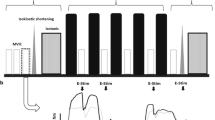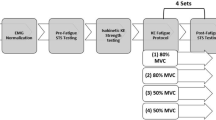Summary
The aim of this study was to calculate the magnitude of the instantaneous muscular power output at the hip, knee and ankle joints during ergometer cycling. Six healthy subjects pedalled a weight-braked bicycle ergometer at 120 watts (W) and 60 revolutions per minute (rpm). The subjects were filmed with a cine camera, and pedal reaction forces were recorded from a force transducer mounted in the pedal. The muscular work at the hip, knee and ankle joint was calculated using a model based upon dynamic mechanics described elsewhere. The mean peak concentric power output was, for the hip extensors, 74.4 W, hip flexors, 18.0 W, knee extensors, 110.1 W, knee flexors, 30.0 W and ankle plantar flexors, 59.4 W. At the ankle joint, energy absorption through eccentric plantar flexor action was observed, with a mean peak power of 11.4 W and negative work of 3.4 J for each limb and complete pedal revolution. The energy production relationships between the different major muscle groups were computed and the contributions to the total positive work were: hip extensors, 27%; hip flexors, 4%; knee extensors, 39%; knee flexors, 10%; and ankle plantar flexors 20%.
Similar content being viewed by others
References
Abbot BC, Bigland B, Ritchie JM (1952) The physiological cost of negative work. J Physiol (Lond) 117:380–390
Andriacchi TP, Andersson GBJ, Ferlier RW, Stern D, Galante JO (1980) A study of lower-limb mechanics during stairclimbing. J Bone Joint Surg 62-A:749–757
American Academy of Orthopaedic Surgeons (1965) Joint motion: method of measuring and recording. 4th reprint 1969. E. & S. Livingstone Ltd., Edinburgh
Bigland-Ritchie B, Graichen H, Woods JJ (1973) A variable-speed motorized bicycle ergometer for positive and negative work exercise. J Appl Physiol 35:739–740
Boccardi S, Pedotti A, Rodano R, Santambrogio GC (1981) Evaluation of muscular moments at the lower limb joints by an on-line processing of kinematic data and ground reaction. J Biomech 14:35–45
Bratt å, Ericson MO (1985) Biomechanical model for calculation of joint loads during ergometer cycling. TRITA-MEK 85-06, ISSN 0348-467X
Cavagna GA, Komarek L, Mazzoleni S (1971) The mechanics of sprint running. J Physiol 217:709–721
Cavagna GA, Thys H, Zamboni A (1976) The sources of external work in level walking and running. J Physiol 262:639–657
Cavanagh PR, Petak KL, Shapiro R, Daly D (1974) Bilateral asymmetry in work output during cycle ergometer exercise. Med Sci Sports 6:80–81
Daly DJ, Cavanagh PR (1976) Asymmetry in bicycle ergometer pedalling. Med Sci Sports 8:204–208
Dempster WT (1955) Space requirements of the seated operator, WADC Technical report, (Wright Patterson Air Force Base Development Center):55–159
Elftman H (1940) The work done by muscles in running. Am J Physiol 129:672–684
Ericson MO, Nisell R, Ekholm J (1984) Varus and valgus loads on the knee joint during ergometer cycling. Scand J Sports Sci 6:39–45
Ericson MO, Ekholm J, Svensson O, Nisell R (1985a) The forces on ankle joint structures during ergometer cycling. Foot & Ankle 6:35–142
Ericson MO, Nisell R, Arborelius UP, Ekholm J (1985b) Muscular activity during ergometer cycling. Scand J Rehab Med 17:53–61
Ericson MO, Bratt å, Nisell R, Németh G, Ekholm J (1986c) Load moments about the hip and knee joints during ergometer cycling. Scand J Rehab Med (in press)
Gordon D, Robertson E, Winter DA (1980) Mechanical energy generation, absorption and transfer amongst segments during walking. J Biomech 13:845–854
Hamley EJ, Thomas V (1967) Physiological and postural factors in the calibration of the bicycle ergometer. J Physiol 191:55–57
Hull ML, Jorge M (1985) A method for biomechanical analysis of bicycle pedalling. J Biomech 18:631–644
Knuttgen HG, Patton JF, Vogel JA (1982) An ergometer for concentric and eccentric muscular exercise. J Appl Physiol 53:784–788
McCartney N, Heigenhauser GJF, Sargeant AJ, Jones NL (1983) A constant-velocity cycle ergometer for the study of dynamic muscle function. J Appl Physiol 55:212–217
Morrison JB (1968) Bioengineering analysis of force actions transmitted by the knee joint. Bio Med Engin 3:164–170
Nordeen-Snyder KS (1977) The effect of bicycle seat height variation upon oxygen consumption and lower limb kinematics. Med Sci Sports 2:113–117
Piemental NA, Shapiro Y, Pandolf KB (1982) Comparison of uphill and downhill walking and concentric and eccentric cycling. Ergonomics 25:373–380
Sargeant AJ, Davies CTM (1977) Forces applied to cranks of a bicycle ergometer during one- and two-leg cycling. J Appl Physiol 42:514–518
Sargeant AJ, Hoinville E, Young A (1981) Maximum leg force and power output during short-term dynamic exercise. J Appl Physiol 51:1175–1182
Williams KR (1985) The relationship between mechanical and physiological energy estimates. Med Sci Sports 17:317–325
Williams KR, Cavanagh PR (1983) A model for the calculation of mechanical power during distance running. J Biomech 16:115–128
Winter DA (1979) A new definition of mechanical work done in human movement. J Appl Physiol 46:79–83
Winter DA (1983) Moments of force and mechanical power output in jogging. J Biomech 16:91–97
Zacks RM (1973) The mechanical efficiencies of running and bicycling against a horizontal impeding force. Int Z Angew Physiol 31:249–258
Zarrugh MY (1981) Power requirements and mechanical efficiency of treadmill walking. J Biomech 14:157–165
Author information
Authors and Affiliations
Rights and permissions
About this article
Cite this article
Ericson, M.O., Bratt, å., Nisell, R. et al. Power output and work in different muscle groups during ergometer cycling. Europ. J. Appl. Physiol. 55, 229–235 (1986). https://doi.org/10.1007/BF02343792
Accepted:
Issue Date:
DOI: https://doi.org/10.1007/BF02343792




